I like to eat especially well when I’m cruising, and I enjoy the juxtaposition of roughing it in a small boat with fine dining while at anchor. I’ve done well with frying and sautéing on camp stoves, but I’ve missed baked goods. I have a camper’s Dutch oven that you cover with coals, but was never brave enough to cook with it when I had campfires. I’ve known about Coleman’s Portable Camping Oven for decades but had never seen one in use. It was time to give it a try; I bought one.
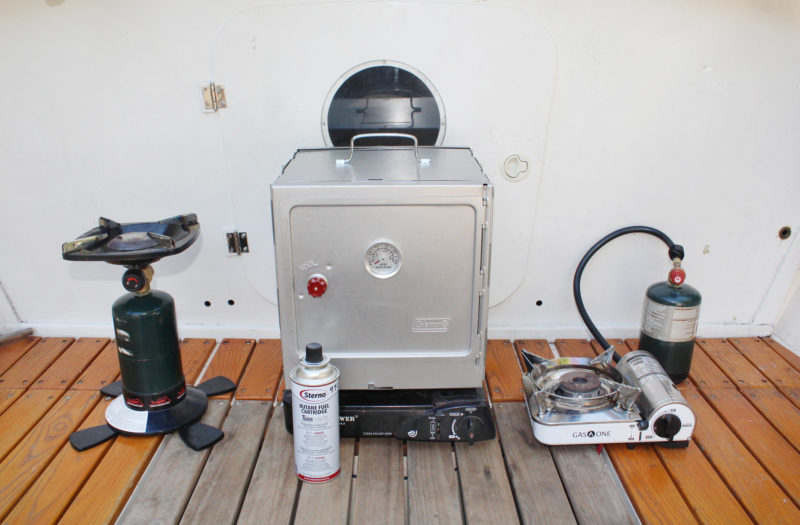 Photographs by the author
Photographs by the authorThe three stoves used for testing the oven are, from left to right: a single-burner stove with a 1-lb propane tank; a portable butane gas range; and the Gas One Mini with the propane adapter.
For my first tests with the oven, rather than go the time and effort of finding a recipe, buying ingredients, and mixing up something, I bought a few tubes of prepared dough for cinnamon rolls and biscuits.
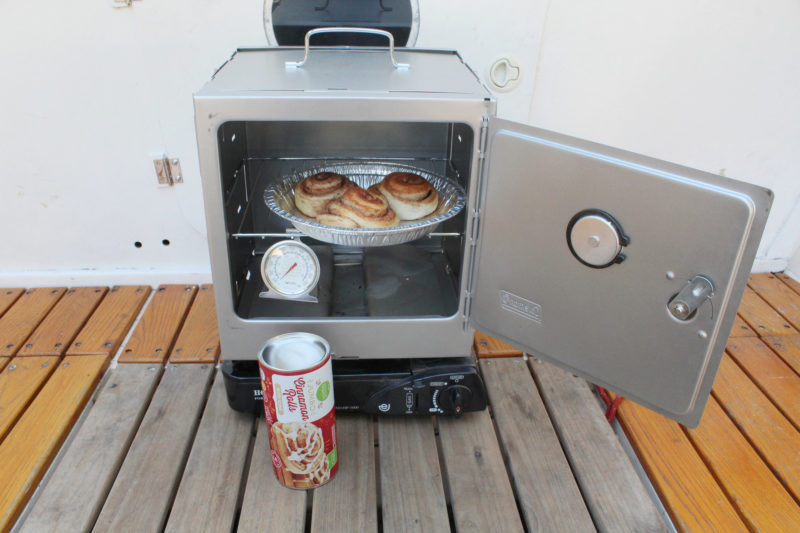
For baking trials, I used premade dough and followed the instructions as well as I could. After relying on the oven’s built-in thermometer for the first trial, I used an oven thermometer to get accurate readings. The disposable aluminum pie pan worked well and didn’t leave the rolls scorched on the bottom.
The cinnamon rolls require baking at 350°F for 20 minutes or until golden brown. For heat, I used a Coleman single-burner camp stove, the kind that screws onto the top of a 1-lb propane cylinder. The base for the cylinder kept the oven perched on top steadily enough. I lit the burner and opened the valve to its maximum setting. After 16 minutes, the oven’s temperature dial was at 340°F and there was no sign of it progressing to 350°F, so I put two cinnamon rolls on a foil pie pan and slid them in. The temperature gauge fell about 10 degrees while the rolls were baking.
I took a peek at about 10 minutes and the rolls had risen well and hadn’t been scorched by the high heat. At 12 minutes they were golden brown and ready to eat.
In spite of the quick bake, the rolls were fluffy, and the bottoms were as golden brown as the tops. I weighed the propane cylinder before and after baking and the combined 28 minutes of warming the oven and baking the rolls had consumed just 2.75 oz of fuel. At that rate the 1-lb canister of propane would, in theory, fuel 163 minutes of baking. (Nearly empty canisters don’t put out as vigorous a flame.)
Next, I tried my butane-fueled stove. I didn’t expect it to do as well—it has a smaller burner head and is quieter than the one-burner propane—but it brought the stove all the way up to 350°F in 16 minutes and continued raising the temperature. I put a new batch of cinnamon rolls in, dialed the flame down—a bit too far at first—then up again to hold at 350°F. Within 13 minutes, the rolls were turning golden brown. Cooking with butane consumed 2.3 oz over the 29 minutes. A full canister contains 7.8 oz of butane, enough for 98 minutes of baking.
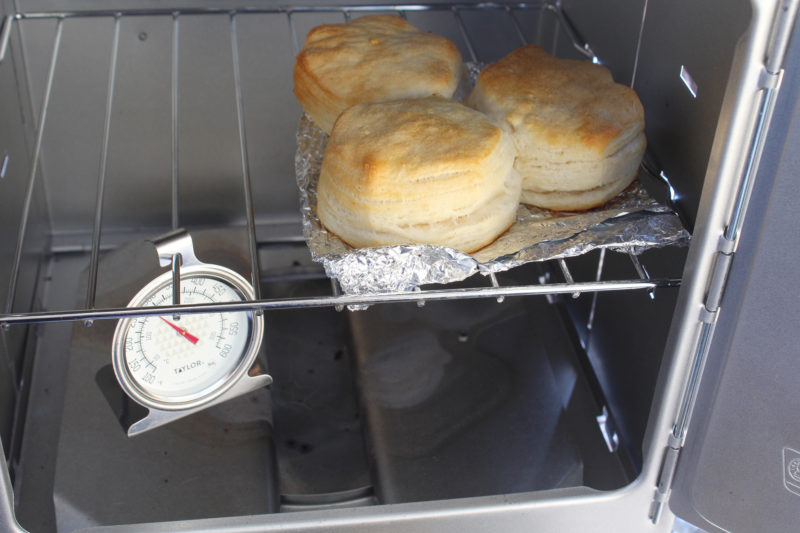
I used doubled aluminum foil for baking the biscuits and, while it worked well in the oven, its flexibility proved challenging while removing the hot food.
The propane had delivered 10.2 minutes of baking heat per ounce, the butane 12.6 minutes per ounce. In the standard 7.8- to 8-oz canisters, butane costs 33¢ per ounce at current U.S. prices; propane in 16-oz canisters costs 58¢ per ounce. I was pleased that butane had the edge for both performance and economy as my butane stoves are the ones I use most often, and they provide a more stable base for the oven. Coleman made the oven for use on its classic two-burner stove, but it works fine with a single-burner stove that has supports long enough to span the 7″-diameter opening in the bottom of the oven.
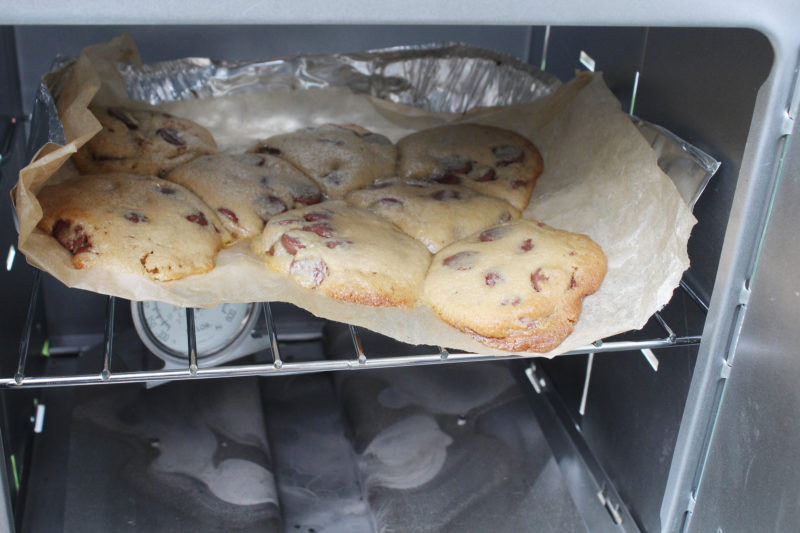
The chocolate-chip cookies spread as they baked, limiting how many I could put in the oven at one time. The parchment paper worked well and didn’t scorch while baking, but it was slippery and should have been supported by a cooking pan with a lip. This batch got away from me and smeared hot chocolate down my shirt front on its way to the ground.
Finally, I tested the oven using my GasOne Mini as the heat source. The Mini is a dual-fuel stove and I used the adapter hose to hook it up to a propane canister. This time, I decided to bake some biscuits and to place an oven thermometer in with them to get a better sense of the internal temperature. In 12 minutes, with the burner going full blast, the oven’s gauge was showing a temperature of 300°F, but the oven thermometer was reading 350°F, just right for the biscuits. The instructions called for baking at 350°F, for 16 to 19 minutes or until golden brown. The biscuits were golden brown in 14 minutes and, like the cinnamon rolls, flaky right through and browned but not scorched on the bottoms.
While the biscuits were baking, I used my laser thermometer to check the temperature of the door around the oven’s gauge. The readings averaged around 155°F—evidently the gauge isn’t calibrated to take into account the cooling effect of the door. Also, it seems likely that the gauge’s readings will vary with the temperature of the ambient air—I did all my baking tests on warm summer days. An inexpensive oven thermometer set inside the oven would be the best indicator.
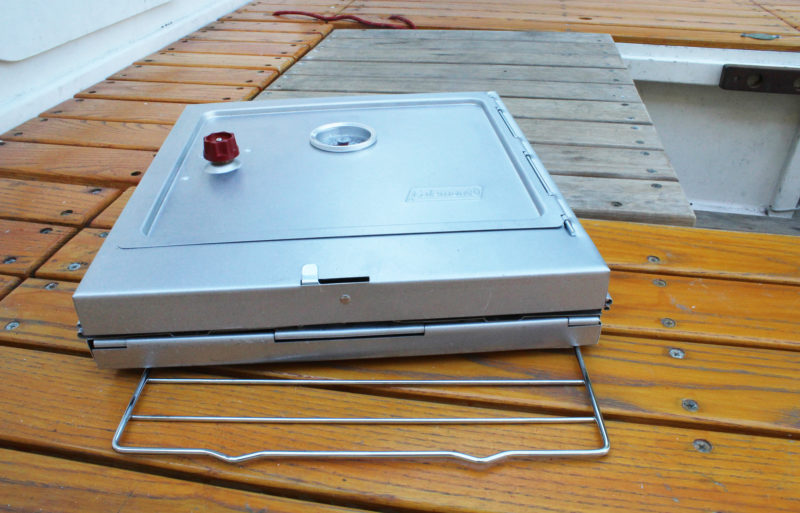
Folded, the oven measures 12-1/4″ top to bottom, 12″ side to side, and 2-1/4″ thick (not including the knob or rack). It weighs 7 lbs 3.3 oz.
I’ve been impressed by how well the Portable Camping Oven performs. When folded up it is smaller than a butane stove, it is easy to set up, and supplies even heat without consuming a lot of fuel. Now I just need to go roughing it with recipes and ingredients for baked goods.![]()
Christopher Cunningham is the editor of Small Boats.
The Portable Camping Oven is made by Coleman and is listed at $37.99. It is available from many retail outlets and online sources for around $50.
Is there a product that might be useful for boatbuilding, cruising, or shore-side camping that you’d like us to review? Please email your suggestions.
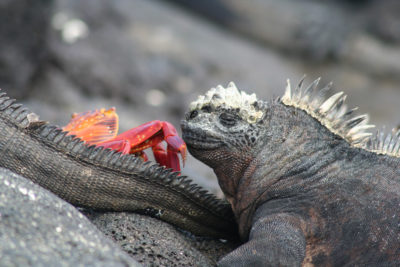
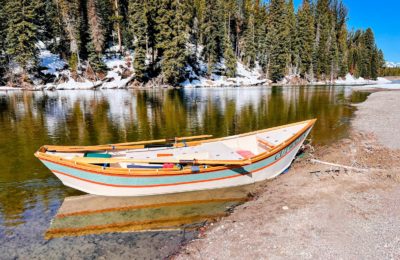
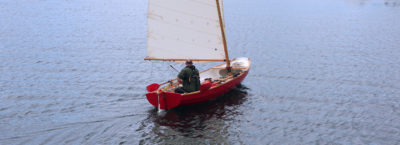
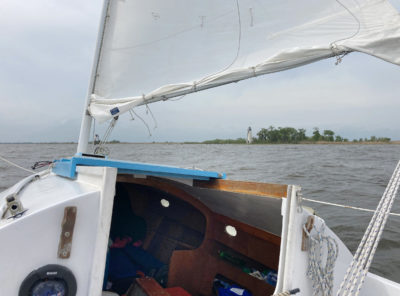
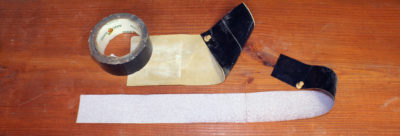
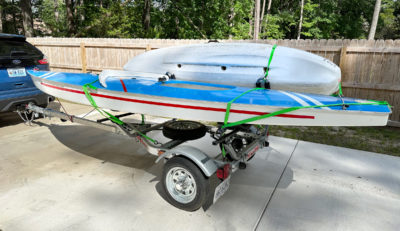
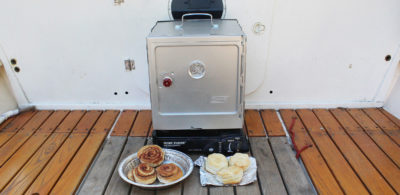

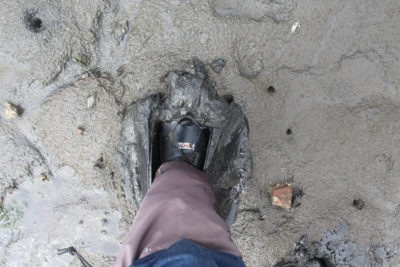
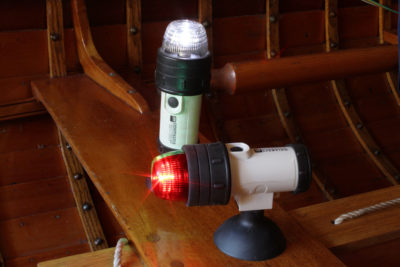
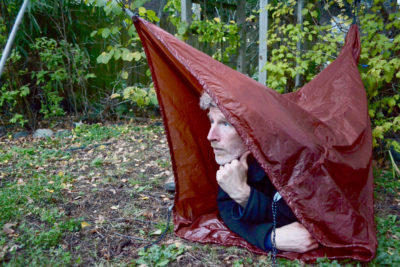
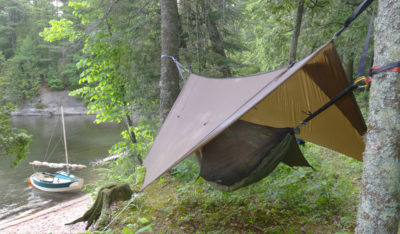
I enjoyed the article, but now I’m hungry:)
A kayaking friend used to bring an aluminum Dutch oven on kayak trips. He carefully calculated how many charcoal briquets would be needed for baking, with briquets not only under the oven but distributed around the lid (which is why the lids have a lip around the rim). At Rugged Point one time he baked a perfect and most delicious apple-cinnamon coffee cake.
He happens to be a skilled outdoor cook. When we were paddling in Haida Gwai some years ago, he had so much food aboard the waterline on his boat was at the hull-deck joint. Another friend on that trip begged off on partaking of the food because he was determined to see whether he could feed himself just with Tasty Bites (Indian or Asian recipes in pouches) for 10 days. Needless to say, the two were at odds the whole trip.
Which reminds me: have you ever run a story or review of this type of camping food, which requires only heating the pouches in boiling water?
No, we haven’t done an article about the boiling-pouch method. I’ve heard of it but never tried it.
—Ed.
It also looks like it might double as a Faraday Cage in a lightening storm. Perhaps their marketing department is missing a hot sales angle.
1) I wonder how this compares to the Omnia Stovetop Oven, other than taking up less space and costing 1/3 less.
2) If baking while at anchor, how would you secure it to the butane stove so it won’t slide off during a passing ferry wake?
The thought of fresh-baked, highly-processed, piping hot apple turnovers after a a few days of grubby dinghy cruising sounds, well, divine! The guiltiest of pleasures.
This is very timely, Chris.
With my new boat I’ve been looking to expand my cooking repertoire beyond boiling and frying. Thanks for doing the work to test this oven.
I’ve just ordered one.
Oven arrived and I finally got around to trying it on my one-burner butane stove. It came up to an indicated 350F in about 6-7 minutes. A batch of baking powder biscuits, cooked on parchment paper sitting on the SS pot lid acting as a baking pan, took about 14 minutes to brown nicely and be done on the inside.
Definitely adding this to my cruising repertoire.
A great article. In 1969/70 I lived in a small cabin I had built off-grid, and cooked on a two-burner propane camp stove. I bought one of the Coleman camp ovens but don’t remember using it much; I believe I was underwhelmed by it. I may have to try one again with the information you provided!
Thinking of children carried as passengers and/or crew, are all external surfaces “too hot to touch” ?
2. Where can one purchase butane these days?
The stove is uninsulated, so the surfaces are hot. I only measured the temperature around the gauge in the door—155 degrees F. I’d keep young kids away from it.
I’ve bought butane cartridges from outdoor, department, and grocery stores.
This was our oven for 2 1/2 years aboard ZOON (ex Bolger LONG MICRO), and across 8 years at a lodge we watched (their commercial oven was a gas hog, but its surface burners were fine). Cooked everything from pies to turkeys. Loved it!
We’ve tried various insulating approaches with them. All help, some more than others. Simple towels work on top, at the easy end, (check for scorching) and fire-felt jackets at the more involved end. Button closures (hook and loop can melt, low down).
Be careful at the low end… flammable and meltable materials are close to flames and highest heat.
A steel sheet (e.g., cookie pan… aluminum has a low melting point) works as a heat diffuser and helps protect insulation extending down the sides.
They also bake slower but just fine on woodstoves.
As a general rule, we never left ours unattended.
You cannot use an infrared thermometer accurately on a glossy (low emissivity) surface.
If you can put a piece of black tape or some flat paint on the surface you will get a more accurate measurement
G’day mate,
From what I understand, whatever is placed upon a canister style butane burner, should never, never overhang the side where the canister is.
Friendly advice mate,
Charles Webster
Quite right, Charles. The instructions include that precaution.